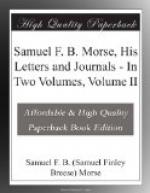Soon after his arrival in New York he began the portrait of Chancellor Kent, and writing of him he says:—
“He is not a good sitter; he scarcely presents the same view twice; he is very impatient and you well know that I cannot paint an impatient person; I must have my mind at ease or I cannot paint.
“I have no more applications as yet, but it is not time to expect them. All the artists are complaining, and there are many of them, and they are all poor. The arts are as low as they can be. It is no better at the South, and all the accounts of the arts or artists are of the most discouraging nature.”
The portrait of the Chancellor seems not to have brought him more orders, for a little later he writes to his wife: “I waited many days in the hope of some application in my profession, but have been disappointed until last evening I called and spent the evening with my friend Mr. Van Schaick, and told him I had thought of painting some little design from the ‘Sketch Book,’ so as not to be idle, and mentioned the subject of Ichabod Crane discovering the headless horseman.
“He said: ’Paint it for me and another picture of the same size, and I will take them of you.’ So I am now employed....
“My secret scheme is not yet disclosable, but I shall let you know as soon as I hear anything definite.”
Still later he says:—
“I have seen many of the artists; they all agree that little is doing in the city of New York. It seems wholly given to commerce. Every man is driving at one object—the making of money—not the spending of it....
“My secret scheme looks promising, but I am still in suspense; you shall know the moment it is decided one way or the other.”
His brother, Sidney Edwards, in a letter to his parents of December 9, 1823, says: “Finley is in good spirits again; not because he has any prospect of business here, but he is dreaming of the gold mines of Mexico.”
As his secret was now out, he explains it fully in the following letter to his wife, dated December 21, 1823:—
“My cash is almost gone and I begin to feel some anxiety and perplexity to know what to do. I have advertised, and visited, and hinted, and pleaded, and even asked one man to sit, but all to no purpose.... My expenses, with the most rigid economy, too, are necessarily great; my rent to-morrow will amount to thirty-three dollars, and I have nothing to pay it with.
“What can I do? I have been here five weeks and there is not the smallest prospect now of any difference as to business. I am willing to stay and wish to stay if there is anything to do. The pictures that I am painting for Mr. Van Schaick will not pay my expenses if painted here; my rent and board would eat it all up.
“I have thought of various plans, but what to decide upon I am completely at a loss, nor can I decide until I hear definitely from Washington in regard to my Mexico expedition. Since Brother Sidney has hinted it to you I will tell you the state of it. I wrote to General Van Rensselaer, Mr. Poinsett, and Colonel Hayne, of the Senate, applying for some situation in the legation to Mexico soon to be sent thither. I stated my object in going and my wish to go free of expense and under government protection.




